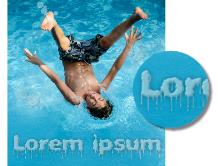You can apply a variety of effects, either alone or in combination, by using the Layer Styles tabbed area of the Layer Properties dialog box. With this feature, you can create visually interesting and creative effects to a layer in real time, and you can fine-tune the effect before applying it. The Layer Styles feature provides six effects: Reflection, Outer Glow, Bevel, Emboss, Inner Glow, and Drop Shadow.
When you apply these effects on a separate layer and save the resulting file in a layer-capable file format (such as the PspImage format), your original image remains unedited on its own layer. In this sense, layer styles are similar to adjustment layers. They differ, however, in that layer styles are applied not to the underlying canvas, but just to the boundaries of the individual layer.
If you resize a layer with one or more layer styles applied to it, the effects are resized proportionally.
Layer styles can be applied only to raster and vector layers.
Some layer styles (such as Drop Shadow) are applied outside the layer’s data. Some layer styles won’t be seen unless the layer includes areas of transparency.
Why is there a "Layer" check box?
When marked, this check box lets you show the layer data with the effects applied. When unmarked, this check box lets you turn off the layer data and just show the effects. Unmarking the Layer check box makes the original layer data behave as if a mask were applied to it.
Is there a reason for the check box order?
Yes. The effects need to be composited in a particular order to obtain sensible results. For example, you would not want a Drop Shadow effect placed on top of its source object, nor would you want an Outer Glow effect placed under a Drop Shadow effect. Thus, the Reflection effect is placed on top, followed by the Outer Glow effect, the Bevel effect, and so on. The Drop Shadow effect is applied last.
What happens when I edit layers with effects?
Whether you edit a vector layer by adding new text or shapes, or edit a raster layer by painting with a brush tool, the effects previously applied to the layer are applied to any modifications you make.

Layers Styles examples
Edit workspace
|
4
|
Drag the Size slider to set the speed with which the reflection fades in comparison with the original layer data. |
|
5
|
Drag the Opacity slider to set the intensity of the reflection’s overall lightness. |

You can save Layer Styles settings as a preset and then apply them at any time to another layer. For more information on saving and applying presets, see Using and creating presets.
Edit workspace
|
4
|
Drag the Size slider to set how far the glow extends outside the layer data. |
|
5
|
Drag the Opacity slider to set the lightness intensity and visibility of the glow. |

You can save Layer Styles settings as a preset and then apply them at any time to another layer. For more information on saving and applying presets, see Using and creating presets.
Edit workspace
|
4
|
Drag the Size slider to set the distance from the outer edge of the layer data to the extent of the bevel. |
|
5
|
Drag the Opacity slider to set lightness intensity and visibility of the bevel. |

You can save Layer Styles settings as a preset and then apply them at any time to another layer. For more information on saving and applying presets, see Using and creating presets.
Edit workspace
|
4
|
Drag the Size slider to set the distance from the outer edge of the layer data to the extent of the embossing. |
|
5
|
Drag the Opacity slider to set lightness intensity and visibility of the embossing. |

You can save Layer Styles settings as a preset and then apply them at any time to another layer. For more information on saving and applying presets, see Using and creating presets.
Edit workspace
|
4
|
Drag the Size slider to set how far glow extends inside the layer data. |
|
5
|
Drag the Opacity slider to set the lightness intensity and visibility of the glow. |

You can save Layer Styles settings as a preset and then apply them at any time to another layer. For more information on saving and applying presets, see Using and creating presets.
Edit workspace
|
4
|
Drag the Size slider to set the distance between the layer data and the shadow. |
|
5
|
Drag the Opacity slider to set lightness intensity and visibility of the shadow. |

You can save Layer Styles settings as a preset and then apply them at any time to another layer. For more information on saving and applying presets, see Using and creating presets.
Edit workspace
|
Drag the Opacity slider to set the light intensity and visibility of the layer data. |
Edit workspace
|
2
|
Click the Layer Effects Visibility Toggle button  to display or hide the effects. to display or hide the effects. |
Copyright 2013 Corel Corporation. All rights reserved.
